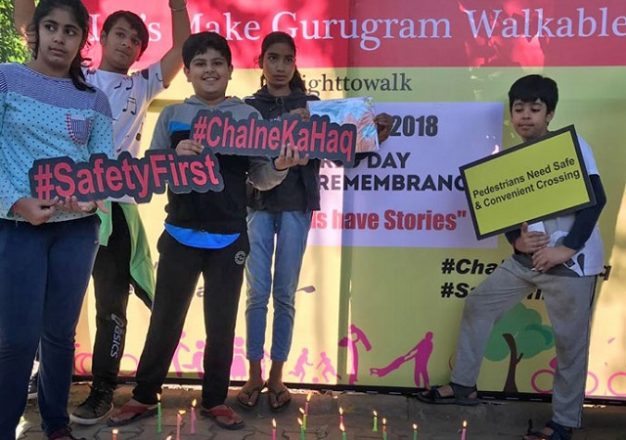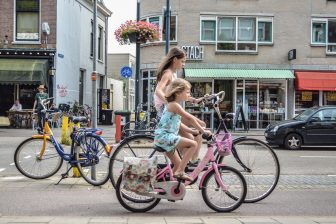
3 Reasons Raahgiri has become India’s urban movement
Raahgiri Day is India’s first sustained car‐free event. It started as a small initiative and has since blossomed into a national movement. Now, it celebrates its fifth birthday.
In too many cities today we see a stark dichotomy. On one side we have enclaves for the rich and powerful, full of luxuries and amenities, and access to the bounties of a globalized world. On the other, there are the disempowered and poor, slumdwellers, and recent migrants, who lack even the most basic services.
But we are also seeing new social and political movements to press back against these trends – novel combinations of interests and community groups that are discovering that the best way forward is through cooperation to build better cities for everyone.
One such movement started on a cold foggy morning in November 2013, south of New Delhi in the financial and industrial hub of Gurugram. On a stretch of road that would otherwise be filled with cars on any given day, hundreds of people followed the sound of short speeches about non-motorized transport and “people-friendly” streets to join bicycle races and stroll the boulevards on foot. Raahgiri Day, as the temporary closure of 4.5 kilometers of roads in the city to encourage non-motorized transport came to be called, quickly became a monthly phenomenon. Five years later the concept has spread to over 70 cities in India.
How has this citizen-led movement spread so quickly in a country where urbanization is so fraught with challenges? Raahgiri has become India’s largest urban movement for three reasons:
1. It’s a platform for positive collaboration
Raahgiri is derived from Raah meaning “path,” while Giri comes from “Gandhigiri,” a form of nonviolent resistance practiced by Mahatma Gandhi. It was born from residents in Gurugram coming together to proclaim their streets as safe spaces for all people – safe from the risk of car crashes and air pollution, but also safe from discrimination by gender, caste, age or income.
Rallying around a positive, apolitical, non-religious message brought support from public, private and community participants. Everyone wanted to see fewer deaths on the roads, less asthma, more physical activity and promote inclusive development.
Today, the Raahgiri platform has also been used to amplify other development programs, like Beti Bachao, Beti Padhao (reducing gender-biased sex selection and encouraging girls education), Swachh Bharat (improving sanitation), Accessible India, and more. Raahgiri has inspired other transport campaigns too, like car-free day challenges, pedal to work challenges, and neighborhood improvement challenges.

2. It’s owned by all
The Raahgiri co-founders in Gurugram later formalized the movement in the form of the Raahgiri Foundation. Yet, ownership of the campaign has little to do with these individuals. There is no common branding for Raahgiri Days and no one “presents” or “powers” these events across dozens of cities. In fact, the organizers of Raahgiri are normally local public agencies.
Cities like Bhopal, Chandigarh, and Jamshedpur used the “Raahgiri” name for their initiative, while Mumbai, Chennai, and Lucknow came up with their own versions. Others, like Bhubaneswar, Pune, and Ahmedabad, started with Raahgiri but changed to local names later.
This is a very important attribute as it’s saved the movement from being too closely associated with any one organization or government, allowing it to be taken on by anyone with a shared interest, wherever they may be.

3. It puts cause before credit
Irrespective of what Raahgiri is called or looks like in different places, the people involved have always put the cause first. If a city, initiates a campaign for promoting walking and cycling through a local Raahgiri event, it gets technical support from those in the foundation and other supporters, like WRI India, a long-time supporter and knowledge partner, even if they don’t brand it as Raahgiri.
In Bhubaneswar, the capital of Odisha, for example, a campaign under the Raahgiri name was a resounding success. Later on, the city transitioned to “Patha Utsav,” a local name for a street festival. However, it continued getting the support from the team.
The commitment from a dedicated and positive community has helped a small experiment in Gurugram reach millions of people in more than 70 cities in one of the fastest-growing urban areas of the world. Indeed, the chief minister of the state of Haryana, Mr. Manohar Lal, recently asked all districts to organize a Raahgiri Day of their own.
Raahgiri Day has demonstrated that it is possible for citizen-led movements to have an impact at the national scale. Residents, public agencies and private companies have come together around a common platform to bring about positive change. As we move towards solving complex urban problems, ensuring people’s basic rights and needs in the face of rapid growth and escalating climate challenges, it’s not a bad idea to take a page out of the Raahgiri story.
Feature Image: WRI India
This article was first published by The City Fix.




